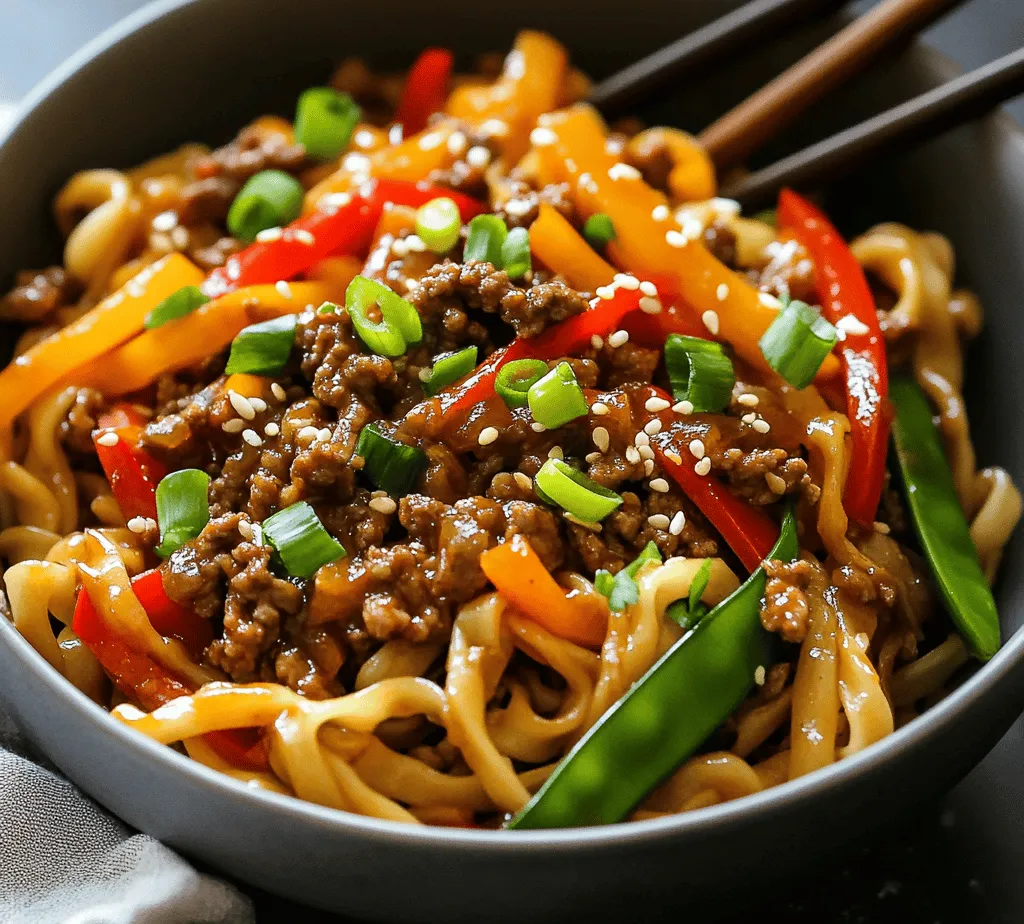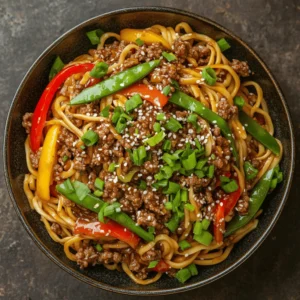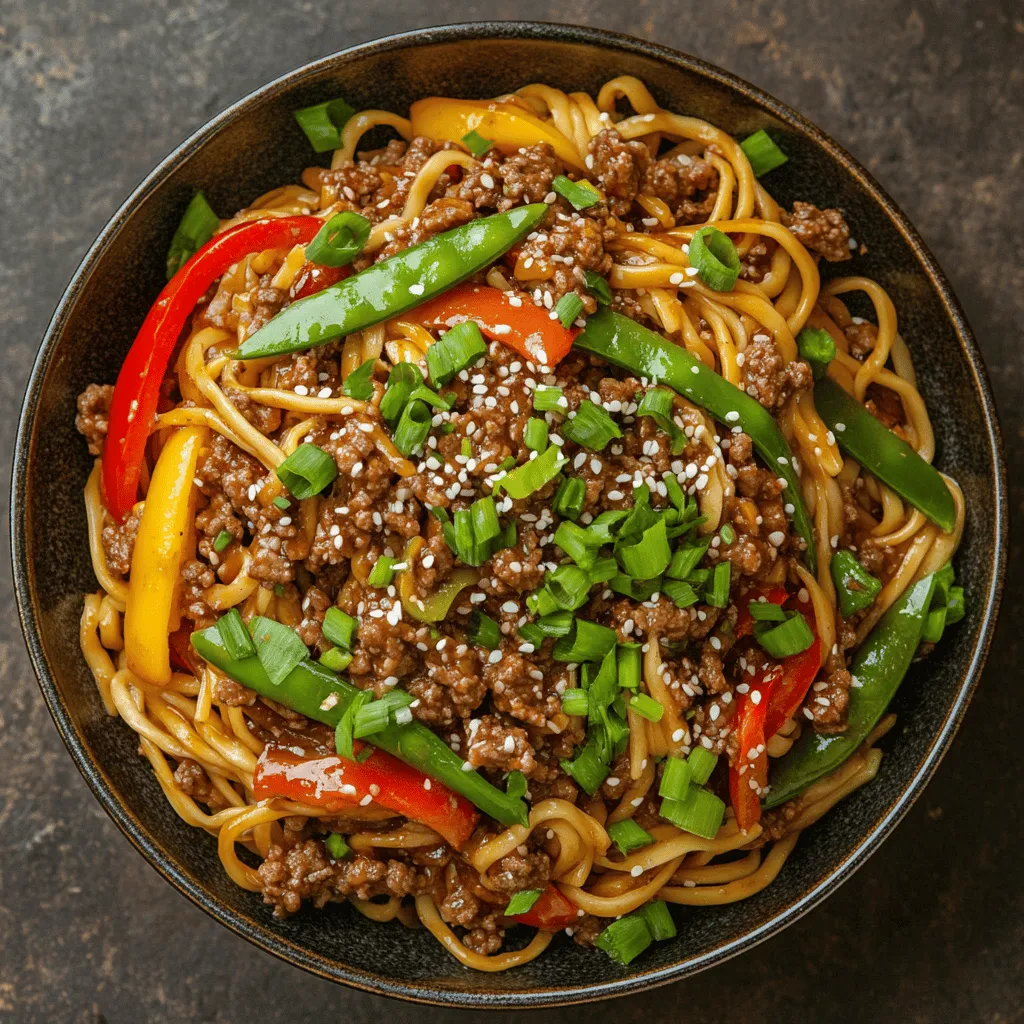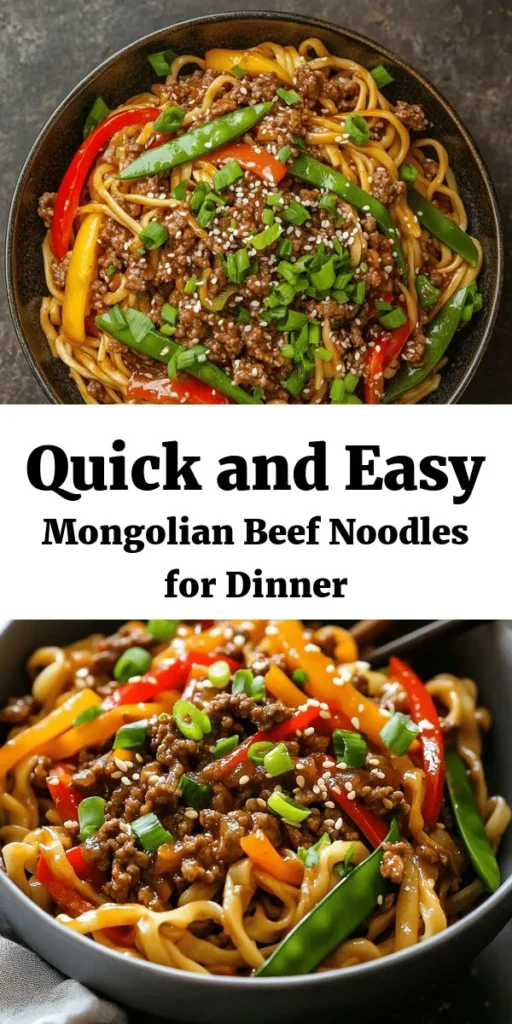Introduction
Exploring the rich flavors of Mongolian cuisine, this Stunning Mongolian Ground Beef Noodles recipe brings an easy and delightful dinner option to your table. With its combination of savory sauces, tender ground beef, and crisp vegetables, this dish is not only quick to prepare but also packed with vibrant flavors that will satisfy your taste buds. In this article, we will delve into the details of this recipe, including its cultural significance, preparation steps, and variations to suit different preferences.
Mongolian cuisine, while often overshadowed by its neighboring culinary giants, is a delightful tapestry of flavors and textures that reflects the nomadic lifestyle of its people. Characterized by hearty ingredients and robust flavors, it encompasses a variety of dishes that are as diverse as the landscapes of Mongolia itself. Ground beef, a staple protein in many Mongolian dishes, is combined with egg noodles and a unique blend of sauces to create a meal that is both comforting and satisfying.
This recipe is perfect for those busy weeknights when you crave a homemade meal but don’t want to spend hours in the kitchen. With just a few key ingredients, you can whip up a delicious and satisfying dish that will impress your family and friends.
Understanding the Essence of Mongolian Cuisine
Exploration of Mongolian Ingredients
At the heart of Mongolian cuisine lies a selection of hearty ingredients that emphasize sustenance and flavor. The harsh climate and nomadic lifestyle have historically shaped the types of foods available to the people, leading to a reliance on meat, dairy, and grains. In this stunning recipe, we will highlight several key ingredients that are not only crucial to the dish but also integral to Mongolian culinary traditions.
Key Ingredients Used in Mongolian Cooking
1. Ground Beef: A versatile protein, ground beef is commonly used in a variety of Mongolian dishes. It is not only quick to cook but also absorbs flavors exceptionally well, making it a favorite choice for stir-fries and noodle dishes.
2. Egg Noodles: These noodles are a staple in many Asian cuisines, including Mongolian. Their chewy texture and ability to hold sauces make them an ideal base for our dish.
3. Soy Sauce, Hoisin Sauce, and Oyster Sauce: These essential sauces form the backbone of many Asian dishes. They contribute rich flavors, umami depth, and a slight sweetness that balances the savory elements of the dish.
4. Vegetables: Fresh vegetables like bell peppers and snow peas not only add color and crunch but also bring nutritional benefits to the table. They are rich in vitamins and minerals, making the dish more wholesome.
5. Aromatics: Garlic and ginger are fundamental in Asian cooking, providing depth and complexity to the flavor profile. Their aromatic qualities enhance the overall taste of the dish, making them indispensable.
Cultural Significance of Noodles in Mongolian Dishes
Noodles hold a special place in Mongolian culture, serving not only as a food source but also as a medium for connection and celebration. Traditionally, noodle dishes are served during communal meals and special occasions, symbolizing togetherness and abundance. The long, unbroken strands of noodles are often associated with longevity, making them a popular choice for celebratory feasts.
Historically, Mongolia’s nomadic lifestyle necessitated the creation of simple yet hearty meals that could sustain families during long journeys. As a result, noodle dishes became a staple, reflecting the culture’s resourcefulness and adaptability. In modern times, these dishes continue to be a favorite, bridging the gap between traditional practices and contemporary tastes.
Ingredients Breakdown for Mongolian Ground Beef Noodles
To create the Stunning Mongolian Ground Beef Noodles, it’s essential to understand each ingredient’s role and how they come together to create a harmonious dish. Below is a detailed overview of the key components you will need for this recipe.
Detailed Overview of Each Ingredient
– Ground Beef: When selecting ground beef for this recipe, look for a blend with around 80% lean meat to 20% fat. This ratio provides enough fat to keep the beef juicy while allowing for a good browning. Ground beef is rich in protein and essential nutrients, making it a nutritious choice for any meal.
– Egg Noodles: Egg noodles come in various shapes and sizes, from wide flat noodles to thin strands. For this dish, you can use either fresh or dried egg noodles. If using dried noodles, be sure to follow the package instructions for cooking times. Fresh noodles usually require less cooking time and will yield a tender texture that complements the savory sauce.
– Sauces:
– Soy Sauce: This salty, umami-rich sauce is a staple in many Asian cuisines. It acts as the primary seasoning for the dish, enhancing the natural flavors of the ingredients.
– Hoisin Sauce: Often described as a sweet and tangy sauce, hoisin adds depth and complexity to the dish. Its unique flavor profile complements the savory elements of the ground beef.
– Oyster Sauce: Made from oyster extracts, this sauce adds a rich, savory flavor that rounds out the dish. It is particularly important for achieving the desired umami taste.
– Vegetables:
– Bell Peppers: These vibrant vegetables add not only color but also a sweet crunch. Rich in vitamins A and C, they enhance the nutritional value of the dish.
– Snow Peas: With their delicate sweetness and crisp texture, snow peas provide a lovely contrast to the tender beef and noodles. They are a great source of fiber and vitamins, making them a healthy addition.
– Aromatics:
– Garlic: Known for its robust flavor, garlic is often used in Asian dishes to add depth. It also boasts numerous health benefits, including anti-inflammatory properties.
– Ginger: Fresh ginger adds a warm, spicy note to the dish, while also providing digestive benefits. Its aromatic qualities are essential in creating a balanced flavor profile.
Step-by-Step Preparation of Stunning Mongolian Ground Beef Noodles
Now that we’ve covered the essential ingredients, let’s dive into the preparation of this delicious dish. Follow these step-by-step instructions to create the Stunning Mongolian Ground Beef Noodles that will delight your family and friends.
Cooking the Noodles
The first step is to cook the egg noodles to perfection. Here’s how to do it:
1. Boil Water: Start by filling a large pot with water and bringing it to a rolling boil. Adding salt to the water can enhance the flavor of the noodles.
2. Add the Noodles: Once the water is boiling, add the egg noodles. Stir gently to prevent them from sticking together.
3. Timing is Key: Follow the package instructions for cooking times. Typically, fresh egg noodles will only need 2-4 minutes, while dried noodles may take 5-7 minutes. Taste a noodle to check for doneness; it should be al dente, meaning it still has a slight bite.
4. Drain and Rinse: Once cooked, drain the noodles in a colander, and rinse them under cold water. This step helps stop the cooking process and prevents the noodles from becoming sticky.
5. Toss with Oil: To further prevent sticking, toss the noodles with a small amount of oil (such as sesame or vegetable oil) before setting them aside for later use.
Creating the Flavorful Sauce
The next step is to create the flavorful sauce that will coat the beef and noodles beautifully. Here’s how to do it:
1. Mix the Sauces: In a small bowl, combine soy sauce, hoisin sauce, and oyster sauce. This mixture will serve as the base for your dish, so adjust the proportions to suit your taste preferences.
2. Add Aromatics: For an added flavor boost, consider incorporating minced garlic and grated ginger right into the sauce mixture. This will allow their flavors to meld together.
3. Adjust for Dietary Restrictions: If you have dietary restrictions, consider substitutions. For a gluten-free version, use tamari or a gluten-free soy sauce. For a vegetarian option, swap ground beef with tofu or tempeh and adjust the sauces accordingly.
Sautéing the Ground Beef
With the noodles and sauce ready, it’s time to sauté the ground beef:
1. Heat the Pan: In a large skillet or wok, heat a tablespoon of oil over medium-high heat. A non-stick pan or a well-seasoned wok works best for this step.
2. Add the Beef: Once the oil is hot, add the ground beef to the pan. Use a spatula to break it apart as it cooks, ensuring an even browning.
3. Seasoning: As the beef begins to brown, season it with a pinch of salt and pepper. This initial seasoning helps to enhance the flavor of the meat.
4. Cook Until Browned: Sauté the beef until it is browned and cooked through, which typically takes about 5-7 minutes. Stir occasionally to prevent sticking and ensure even cooking.
5. Incorporate Aromatics: Once the beef is browned, add the minced garlic and grated ginger to the pan. Sauté for an additional minute until fragrant, making sure not to burn the garlic.
With the ground beef perfectly sautéed and infused with aromatic flavors, you’re ready to combine all the elements and create a stunning dish that will transport you straight to the heart of Mongolian cuisine. In the next segment of this article, we will explore how to bring everything together, adding the cooked noodles and vegetables to create a sumptuous meal that is not only quick to prepare but also a feast for the senses. Stay tuned for the delightful conclusion of this easy Mongolian Ground Beef Noodles recipe!

Incorporating Aromatics and Vegetables
To truly elevate your Mongolian ground beef noodles, the right timing for adding aromatics is essential. Start by heating your cooking oil in a large skillet or wok over medium-high heat. As the oil shimmers, add the minced garlic and grated ginger. These two ingredients are the backbone of flavor in this dish, and adding them at this stage allows their essential oils to release and permeate the dish. Let them sizzle for about 30 seconds until they become fragrant, but be careful not to burn them, as that can introduce a bitter taste to your meal.
Next, introduce your selection of vegetables. A classic combination includes bell peppers, snap peas, and carrots. To maintain a delightful crunch while ensuring tenderness, slice your vegetables uniformly, ideally into thin strips. This allows for even cooking. Add the vegetables to the skillet immediately after the aromatics, and stir-fry them for about 2-3 minutes. The goal is to soften them slightly while preserving their vibrant colors and crisp textures. Stir frequently, allowing them to absorb the flavors from the garlic and ginger.
Combining Ingredients for a Harmonious Dish
Once your aromatics and vegetables have reached the desired tenderness, it’s time to combine everything for a harmonious blend of flavors. Return the cooked ground beef to the skillet and pour in your prepared sauce, which typically consists of soy sauce, hoisin sauce, and a splash of rice vinegar. These ingredients bring depth and complexity, and simmering is essential for melding these flavors together. Lower the heat and allow the mixture to simmer for about 5 minutes, stirring occasionally to prevent sticking.
While simmering, add the cooked noodles to the skillet. It’s crucial to ensure that the noodles are well-coated with the sauce and combined evenly with the beef and vegetables. To achieve this, gently toss the ingredients with tongs or a spatula, ensuring that each strand of noodle is enveloped in the rich, savory sauce. If the dish seems dry, consider adding a splash of water or broth to help the sauce cling to the noodles.
Garnishing and Serving Suggestions
Creative Garnishing Ideas
Presentation plays a significant role in the enjoyment of a meal. For your Mongolian ground beef noodles, garnishing is an excellent way to enhance visual appeal. Start by finely chopping fresh green onions and sprinkling them generously over the top of your dish. The bright green color adds a fresh touch, while the mild onion flavor complements the savory notes of the dish.
Additionally, toasted sesame seeds are a fantastic garnish that adds both flavor and texture. Simply toast raw sesame seeds in a dry skillet over medium heat for a few minutes until golden brown. Sprinkle these over your noodles just before serving. For an extra layer of taste and color, consider adding fresh cilantro or a few slices of red chili for those who enjoy a little heat.
Serving Suggestions for a Complete Meal
To create a well-rounded dining experience, consider pairing your Mongolian ground beef noodles with complementary side dishes and drinks. A light cucumber salad dressed with rice vinegar and sesame oil works beautifully, providing a refreshing contrast to the richness of the noodles. For drinks, a chilled green tea or a light lager can enhance your meal without overpowering the flavors.
When plating your dish, aim for a restaurant-style presentation. Use a large, shallow bowl and twirl the noodles into a nest shape in the center. Arrange the beef and vegetables artfully on top, ensuring a vibrant display of colors. Finish with your garnishes and serve with chopsticks for an authentic touch.
Exploring Variations and Customizations
Vegetarian and Vegan Adaptations
For those looking for a vegetarian or vegan version of this dish, there are several delicious substitutions. Instead of ground beef, you can use crumbled tofu or tempeh, which can absorb the rich flavors of the sauce beautifully. Additionally, consider adding more vegetables, such as mushrooms, zucchini, or baby corn, to create a hearty and satisfying meal.
To maintain the umami flavor profile, opt for soy sauce or tamari as a base for your sauce, and include a touch of miso paste for added depth.
Spice Level Adjustments
If you enjoy a little heat in your meals, there are easy ways to adjust the spice level of your Mongolian noodles. Incorporate chili paste or sriracha into the sauce for a kick of spice, or add finely chopped fresh chilies during the cooking process. Keep in mind that balancing flavors is key; if you’re increasing the spice level, consider adding a touch of sweetness (like a bit of sugar or honey) to counteract the heat.
Nutritional Information and Health Benefits
Understanding the nutritional value of your meal can help you make informed choices. A typical serving of Mongolian ground beef noodles contains approximately 450-500 calories, depending on ingredient variations. This dish provides a well-rounded mix of protein from the beef or meat substitutes, carbohydrates from the noodles, and essential vitamins and minerals from the vegetables.
Key ingredients also boast health benefits. For example, garlic and ginger are known for their anti-inflammatory properties and can aid in digestion. The vegetables add fiber, which is essential for maintaining a healthy digestive system, while the soy sauce offers a source of protein and adds flavor without excessive calories.
Conclusion
In summary, this Stunning Mongolian Ground Beef Noodles recipe not only offers a delicious and quick dinner solution but also provides an opportunity to explore the rich flavors of Mongolian cuisine. With its balance of savory sauces, tender beef, and fresh vegetables, this dish stands out as a delightful meal that can be easily customized to suit various dietary needs and preferences. Enjoy the process of cooking and savor the delightful flavors that this recipe brings to your table. By incorporating these tips and suggestions, you can create a stunning and memorable dining experience that will impress your family and friends. Whether you stick to the classic version or venture into creative adaptations, this dish is sure to become a favorite in your home cooking repertoire.



